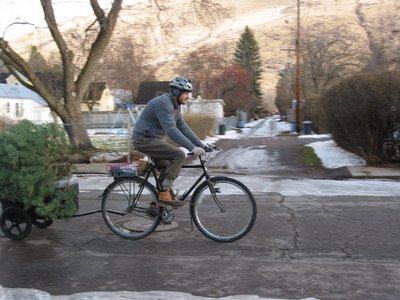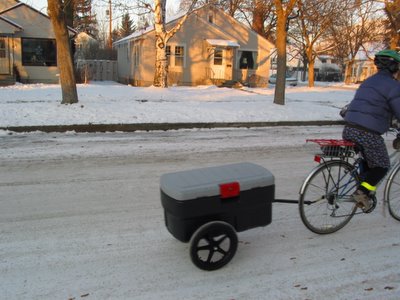There's no way around it. In the US, being a cycler shoves one to the edges of things. This isn't always a bad thing, though, as in the edge of the road (or the edge of sanity, in the minds of many). As a cycler, I've come to see beauty in the edges of things. Often, they're the neatest places to be. And, just as often, I have them all to myself.
It's not so much that a bicycle is
less suited to being in the center of attention. It's that a bicycle is so well suited to taking in the margins. Being able to comfortably move at ten miles per hour and requiring only about 2 feet for passage makes a difference; that's for sure. So does not being surrounded by the thing transporting you, as
Todd F. timelessly captures.
Perhaps it's the dreary weather, but I've been focusing too much on the negatives of being pushed to the edges of things (the road, specifically). But, usually, it's a privilege I wouldn't give up easily. John, who has a great blog
Bike Year, noted how things we could drive past forever without notice suddenly become the focus of our attention on a bike. Scraping a windshield is scraping a windshield, but a cycler picks up on
the edges of seasons long before the frost ends or the sun bakes.
As I made my way home from the office yesterday about 3:00, a thermometer gave the temperature as 33 degrees, and the sleet stinging my face gave the rest. Still, there was something in the air--was it a smell or a feel?--that gave me the oddest sense of warmth, even as the sleet coated my sweater and beard with icy dampness. Finally, my mind found the page in its journal. Last year, in weather just like this, I'd been riding around the valley trying to find a road that would lead me up. Ice and snow kept turning me back. Finally, I'd found a perfectly plowed road that climbed up and up and, eventually, ended at the most remarkable edge. "We're going to ride there, right?" a voice in my head seemed to say, "Right?" What separates us cyclers from everyone else is that we tend to say "Yes" to those voices.
I raised my pace to a very brisk walk and smiled through the sleet on my way home. Once there, I slipped on a second sweater, heavier mittens, a helmet, and packed a windshirt and a water bottle on the bike. I stuffed dried figs, pistachios, and a headlight in my pockets, and I was off. Even with traffic downtown and the long climb at the end, I should be able to make it to the hilltop before dark.
The clouds producing this sleet were leaden and low, draping the hills and trapping foul exhaust in the valley. Still, my legs felt good as they warmed up, and the promise of a memory made the crisp air sweeter. I'm on the singlespeed today, geared low for plowing through snow and toting loads. Even so, I keep up with traffic downtown and race green lights for the other side.
Soon, I'm climbing the bike/ped bridge over the railyard that marks the northern edge of downtown. At the top, I look out to the west where a break in the clouds reveals some of the sprawling new development that is slowly engulfing the valley. My hilltop perch was the edge of a particularly brash one of these developments, knifing its way in a defiant spiral of luxury homes up a tired old mountain. I got the sudden sick feeling that my remembered edge might now be reduced to a center, of a house, of a driveway, of a manicured lawn. May have been rendered unfit for a reverent cycler to sit upon and shell pistachios. But, edges can still be tenacious even in the "new" west, and the barbed wire I remembered had marked this one as a fighter.
I rode as if the sod or foundation or no trespassing sign might be laid any minute. Past the clanking railyard on my left and the silent cemetery on my right I rode. Winding unnecessarily but pleasantly--the way old roads can do without pretense--I began watching for the hill as it came into view. I tried in vain to see my spot in the breaks between clouds there and traffic here.
With two last defiant flourishes, my old road conceded to the new, straight, six lanes of smooth asphalt. I darted into the bike slip lane between waves. No time to look at the mountain now. A headwind slowed my progress, but I soon passed under the Interstate. The road narrowed quickly. Four lanes, two lanes. And steepened. I took the second left, from memory, and rode up to a . . . dead end. This entire neighborhood had gone up in a year and completely fooled me. Like a plane flight, some progress is so rapid that it disorients the mind. Picking my way through slushy, icy patches, I carefully descended to the main road.
The second left revealed roads with names more familiar--Klondike, Prospect, Miner, Bonanza. A tangled web of cul-de-sacs and pretentious curves. After two more false climbs into squid-like dead ends, I found the right road. I sweated pleasantly up a long series of curves. The sweeping views changed with the curves. Now I was looking long into the wild northern hills. Now at rolling high pastures. Now at the neatly planned imperfection of a modern housing development. Now back to the city at rush hour, but moving so slowly at this distance. Always moving up.
Finally, I rounded the last curve. A huge new house was nearly finished, and two more were underway. But, the end of the street looked the same. A lone, unmarked gate played sleeping watchman to my treasured hillock. I dismounted at the gate and pushed my bike up the short stretch to the top of the hill.
Amazingly, things were just as I had found them last year. Right down to the ten foot circle of soft, bare grass in the middle of the patchy snow where deer bed down for the night. Twenty feet in any direction, I'm encroaching on someone's claim. Yards to the south, a posted water tank to the east, and barbed wire to the west and north. But, I don't need half the space that's left, this tiny margin separating past from present is plenty large for a humble cycler. I lay my bike carefully on its side, sit down, and shell pistachios as I take in the view.
I smile at everyone below making their way hurriedly in the middle of things. I'm content and happy that they leave the edges to characters like me.
Labels: ride stories










